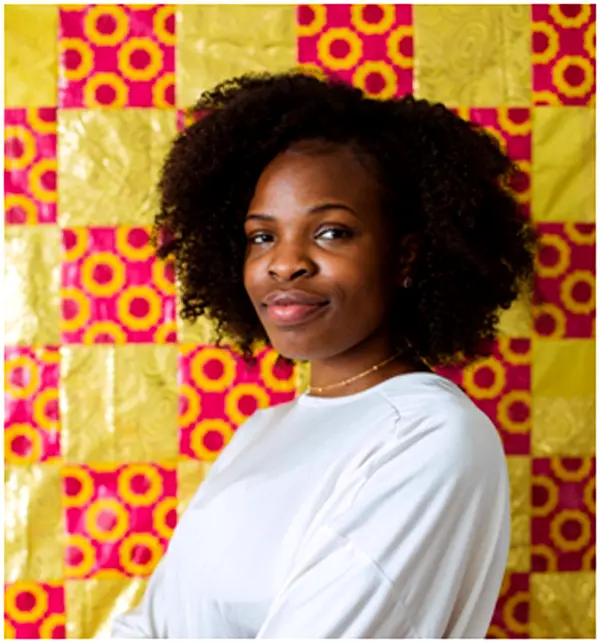Whether a party, wedding or church event in Nigeria, one striking accessory stands out on the women in attendance—their ‘gele’. Gele as headdress is an art form in itself, widely worn in Nigeria for social occasions and events. It has become a statement piece—a main focus of fashion attire—that exudes cultural pride and history.
A Yoruba adage of old says “…a woman’s fashion is incomplete without her gele.” and this saying has proven its resilience in contemporary African culture; now forming a major inspiration of captivating works by Nigerian artist, Layo Bright.
Layo Bright is a sculptor and visual artist currently based in New York, whose distinct remarkable artworks highlight textiles such as gele and “Ghana must go” bags. Having grown up in Lagos, Nigeria, she recalls her earliest encounters with gele material, “I remember getting ready for church on Sunday mornings and watching my mum tie her gele. Her process was almost ceremonial: picking through various colours, the sounds of the hard fabric as she wrapped it around her head, the squeezing of her face as it tightened around her ears, and the smile of satisfaction as she structured her headdress to a desired shape…I was in awe!”
This sense of awe is palpable in Bright’s sculptures of female heads that are adorned with gele of different colours and shapes, some of which are self-portraits of the artist and family members. She deftly wraps hard pieces of fabric, layer by layer, on each work; mimicking the movements she recalls from years of watching the women in her life adorn themselves. “It’s mostly muscle memory I use to make the headdresses …thinking of the way I’ve seen it tied…and I go off that to assemble the works.”
For several centuries, gele has been used as a head adornment in Yoruba culture—and in several African cultures and the black diaspora globally—gaining wide grown popularity in Nigeria in the mid-20thcentury with the boom in social events following Nigeria’s independence from the British in 1960.
Nowadays no event is complete without a bevy of guests crowing their heads in the stiff fabric—in expression of kinship, culture and solidarity. Gele now comes with scalloped edges, laser-cut designs, hand-beaded, two-tone effects, Swarovski-encrusted, hand-painted, embroidered, sequined, and any other design aesthetic you can think up. It has made its way to broad international space as seen in Beyoncé’s Black Is King film of 2020, as the 21st century fashion space gets more ethnic in textures.
Bright’s eye-catching head sculptures have gained much acclaim, featuring in several notable international exhibitions including To Heal and Protect, Welancora Gallery, Brooklyn, NY; I Am Not A Goddess…Unless I Say I Am, Alliance Française – Mike Adenuga Centre, Ikoyi, Lagos; SOMETHING ABOUT US, Anthony Gallery, IL; A Chance Encounter, Parts & Labor, NY; You Don’t See Me, Cuchifritos Gallery + Project Space, NY; Migration(s) and Meanings in Art, Meyerhoff Gallery at MICA, MD; Maid in Nigeria, Untitled AWCA, Lagos; Through Her Eye, Mana Contemporary, IL; Carry Over: New Voices from the Global African Diaspora, Smack Mellon, NY; Reality Check, Sotheby’s Institute of Art, NY; among others.
She received her LL.B (Hons.) from Babcock University (Ogun State, Nigeria) and an MFA in Fine Art (Hons.) from the Parsons School of Design (New York, USA) in 2018. Bright is the recipient of honors and awards including the UrbanGlass Winter Scholarship Award, and the International Sculpture Center’s Outstanding Student Achievement in Contemporary Sculpture Award, and the Beyoncé Formation Finalist Scholarship.
With an intuitive and creative use of materials that explore black history, femininity and culture, it’s no wonder that Bright is making great strides in the art world.



